Comfort on the Course: The Best Golf Shoes for Plantar Fasciitis Sufferers
Plantar Fasciitis is a common foot condition that causes pain and inflammation in the plantar fascia, a thick band of tissue that runs along the bottom of the foot. This condition can make it difficult to walk and participate in physical activities, including golfing. However, with the right shoes, golfers with plantar fasciitis can still hit the green in comfort.
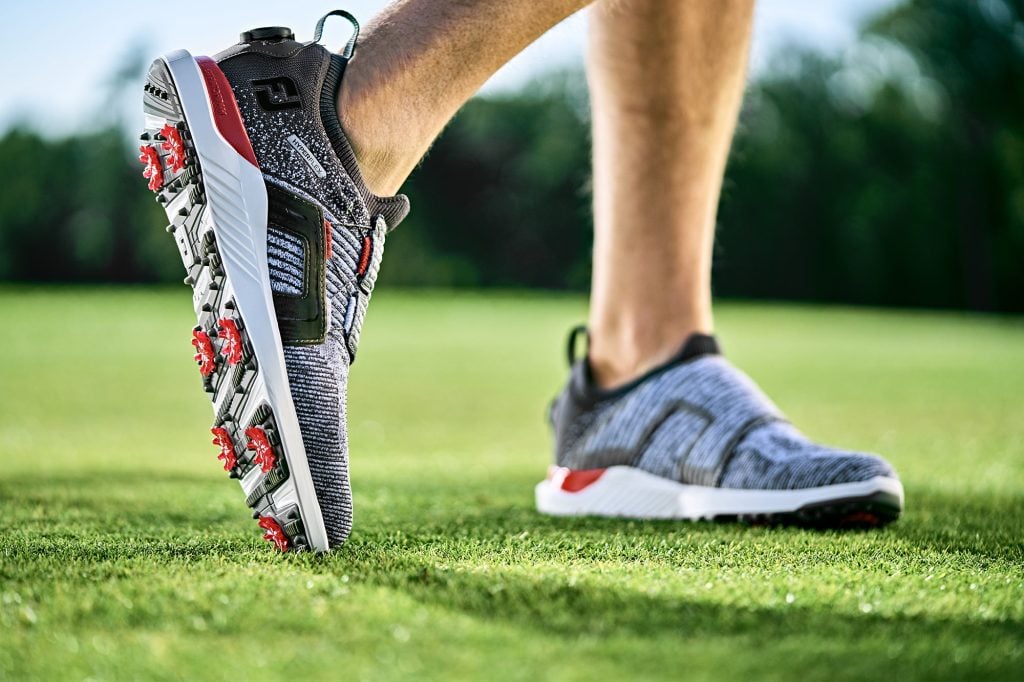
Plantar Fasciitis is often caused by repetitive strain and overuse of the foot, leading to small tears in the plantar fascia. It can also be aggravated by high impact activities such as running and jumping. Golfers who walk the course may also experience pain due to the repetitive nature of the sport.
Symptoms of plantar fasciitis include sharp pain in the heel or arch of the foot, especially in the morning or after prolonged periods of sitting or standing. Diagnosis is typically made through a physical exam and possibly imaging tests such as X-rays or MRIs.
When looking for the best golf shoes for plantar fasciitis, there are several key features to consider:
- Supportive Arch: Look for shoes with good arch support to help distribute weight evenly and reduce strain on the plantar fascia.
- Cushioned Heel: A cushioned heel can absorb shock and reduce pressure on the heel, where pain is often felt with plantar fasciitis.
- Wide Toe Box: A wide toe box can help prevent crowding and relieve pressure on the toes, which can be beneficial for those with plantar fasciitis.
- Flexible Sole: A flexible sole can help with foot movement and reduce strain on the plantar fascia.
- Good Traction: Proper traction is important for stability and balance during a golf swing.
When choosing golf shoes for plantar fasciitis, it’s essential to consider the fit, as well as support and cushioning. Look for shoes with breathable materials to keep feet cool and dry, and consider using orthotic inserts for added support. Additionally, taking breaks and stretching before and after golfing can help manage symptoms.
By following these guidelines and investing in the right golf shoes, golfers with plantar fasciitis can continue to enjoy the sport without being held back by foot pain.
Key Takeaways:
- Look for golf shoes with supportive arches to alleviate pressure on the plantar fascia and provide stability while walking on the course.
- Cushioned heels can absorb shock and reduce impact on the heel, which is often a common area of pain for those with plantar fasciitis.
- Wide toe boxes allow for natural movement and can prevent discomfort and irritation on the toes, which can aggravate plantar fasciitis symptoms.
What Is Plantar Fasciitis?
Plantar Fasciitis is a common foot condition that occurs when the plantar fascia, a thick band of tissue connecting the heel bone to the toes, becomes inflamed. This can cause stabbing heel pain, particularly in the morning or after extended periods of standing or physical activity. To help relieve the discomfort associated with Plantar Fasciitis, it is recommended to wear supportive shoes with cushioning and arch support, such as the New Balance Fresh Foam golf shoes.
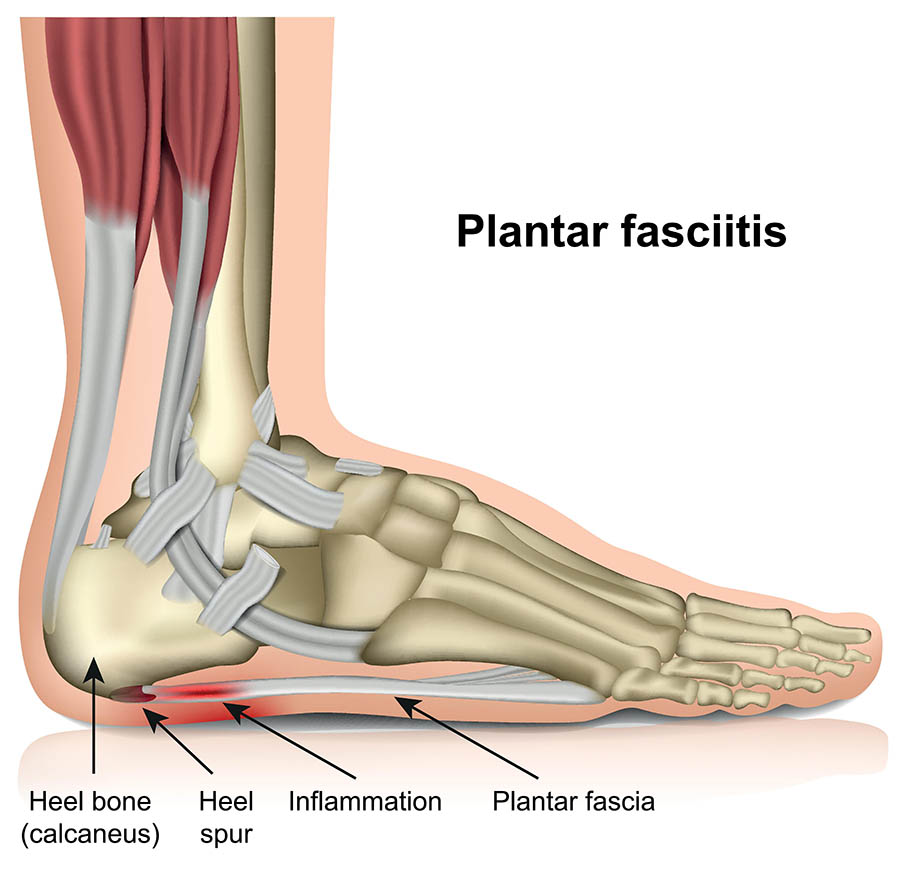
What Causes Plantar Fasciitis?
Plantar fasciitis is usually caused by overuse, wearing improper footwear, standing for extended periods of time, or engaging in high-impact activities. So, what causes plantar fasciitis? Continuous stretching and tearing can result in inflammation of the plantar fascia, leading to discomfort and pain in the heel.
How To Identify Plantar Fasciitis?
- The initial step in identifying plantar fasciitis is experiencing heel pain, especially when taking the first few steps in the morning.
- Another sign is heel pain after standing or sitting for an extended period.
- Additionally, if you feel a stabbing pain in your foot after exercising, it could be a symptom of plantar fasciitis.
Pro-tip: If you suspect plantar fasciitis, it is recommended to consult a podiatrist for a proper diagnosis and treatment plan.
What Are The Symptoms Of Plantar Fasciitis?
The symptoms of plantar fasciitis usually consist of heel pain, particularly when taking the first steps in the morning or after long periods of rest. The pain may also occur after standing for extended periods or engaging in intense physical activity. Some individuals may also experience swelling and tenderness in the heel area.
While the symptoms may differ from person to person, early detection and appropriate treatment can result in successful recovery and the ability to lead an active lifestyle without pain.
How Is Plantar Fasciitis Diagnosed?
These golf shoes are like a hug for your feet – supportive, cushioned, wide, flexible, and with good traction, perfect for dealing with the pain of plantar fasciitis while still looking stylish on the course.
What Are The Best Types of Golf Shoes For Plantar Fasciitis?
If you suffer from plantar fasciitis, you know that finding the right shoes can be a game-changer for your comfort and performance on the golf course. In this section, we will discuss the top features that make a golf shoe suitable for those with plantar fasciitis. From supportive arches to cushioned heels, a wide toe box to a flexible sole, and good traction, we will break down the must-have elements for the best golf shoes for plantar fasciitis. So, let’s get started and find the perfect pair for you!
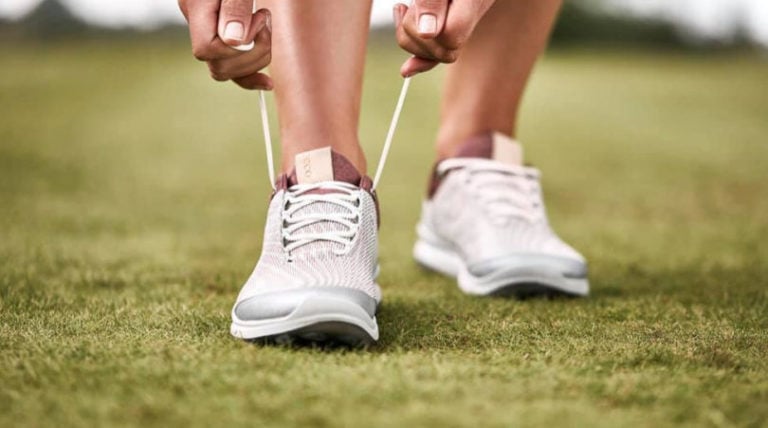
1. Supportive Arch
- Select golf shoes with a built-in supportive arch to relieve discomfort caused by plantar fasciitis.
Don’t let your heel be the sore loser on the golf course – opt for a cushioned pair of golf shoes for plantar fasciitis.
2. Cushioned Heel
- Choose golf shoes with adequate cushioning in the heel to alleviate pressure on the plantar fascia.
- Ensure the cushioning is responsive and provides impact absorption during each step on the golf course.
- Look for heel cups that offer stability and support, reducing strain on the plantar fascia.
Give your toes some extra wiggle room and say goodbye to cramped feet with these wide-toe-box golf shoes for plantar fasciitis.
3. Wide Toe Box
- When selecting golf shoes, opt for those with a 3. wide toe box to ensure enough room for toe movement and to avoid putting pressure on the toes.
4. Flexible Sole
- Choose golf shoes with a sole that allows for natural foot movement and reduces strain on the plantar fascia.
- Look for shoes that offer flexibility in the forefoot and midfoot areas to support the foot’s natural biomechanics.
- Make sure the sole provides sufficient shock absorption to cushion the impact of each step.
Did you know? The plantar fascia is a thick band of tissue that runs across the bottom of your foot and helps support the arch, playing a crucial role in maintaining balance and stability.
5. Good Traction
- Choose golf shoes with excellent traction to ensure stability and prevent slipping during swings and walks on the course.
- Look for shoes with strategically placed traction patterns on the outsole to offer great grip on various surfaces.
- Consider golf shoes with replaceable spikes or hybrid outsoles for versatile traction on different terrains.
What Are The Best Plantar Fasciitis Golf Shoes?
Plantar fasciitis, a common foot condition characterized by heel pain, can be a significant hindrance for golfers. The repetitive walking and the stance required for golf can exacerbate the condition if not supported by the right footwear. Finding golf shoes that provide the necessary support and comfort is crucial for those dealing with plantar fasciitis. In this blog, we will explore some of the best golf shoes that offer the perfect blend of comfort, support, and style for those suffering from this condition.
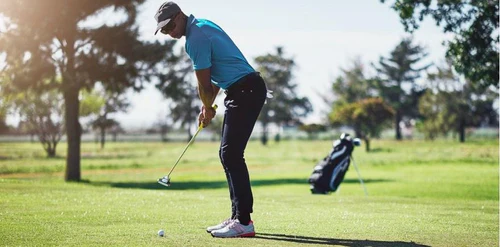
1. Adidas Tech Response 4.0WD
Adidas is renowned for its commitment to comfort and performance, and the Tech Response 4.0WD is no exception.
Key Features:
- Enhanced arch support to minimize the strain on the plantar fascia.
- Lightweight mesh upper for breathability.
- Thintech cleats for better traction and stability.
Best For: Golfers looking for a shoe that combines lightweight comfort with reliable support, especially for those long days on the course.
2. New Balance Minimus Tour
New Balance shoes are often recommended for those with foot problems, and the Minimus Tour is a great option for golfers with plantar fasciitis.
Key Features:
- REVlite midsole provides excellent cushioning and support.
- Waterproof upper to keep your feet dry in all conditions.
- Ortholite insole for additional arch support.
Best For: Players who need extra support and prefer a more traditional-looking golf shoe.
3. Skechers Go Golf Elite V.3
Skechers has made a name for itself in the golf shoe market, especially when it comes to comfort, and the Go Golf Elite V.3 is ideal for those with plantar fasciitis.
Key Features:
- High-performance Resamax cushioned insole.
- Waterproof upper with a durable grip TPU bottom plate.
- The low drop design keeps the foot in a neutral position.
Best For: Golfers who prioritize supreme comfort without sacrificing performance.
4. FootJoy Pro/SL
FootJoy’s reputation in the golfing world is well-earned, and the Pro/SL provides excellent support for those with plantar fasciitis.

Key Features:
- Fine-tuned foam (FTF) for cushioning and comfort.
- Perimeter weighted outsole for increased stability.
- Laser Plus Last offers a full rounded toe character, standard fit across the forefoot and instep, with a slightly narrow heel.
Best For: Players looking for a blend of traditional styling and modern technology, with a focus on stability.
5. Ecco Biom Hybrid 3 Gore-Tex
Ecco’s BIOM line is designed for natural motion and excellent support, making the Biom Hybrid 3 Gore-Tex a great choice.

Key Features:
- BIOM technology promotes natural foot movement.
- Gore-Tex Waterproof technology.
- ECCO YAK leather for durability and breathability.
Best For: Golfers who prefer a modern, sporty design and require high-level waterproof
and breathable features, along with excellent foot support.
6. Addidas ZG21
Overview: Adidas ZG21 is a lightweight yet stable spiked golf shoe that provides exceptional support and comfort, making it ideal for players with plantar fasciitis.

Key Features:
- Lightweight with a low-profile design, ensuring stability and reducing foot fatigue.
- BOOST midsole offers responsive cushioning.
- Six-spike outsole for superior traction.
Best For: Golfers who play in wet or slippery conditions and require maximum grip, along with support for plantar fasciitis.
7. Puma Ignite Pwradapt Caged
Overview: The Puma Ignite Pwradapt Caged features a unique design that offers excellent support and stability, which is essential for those suffering from plantar fasciitis.

Key Features:
- Adaptive fit system that provides a locked-in feel.
- IGNITE foam in the midsole for energy return and comfort.
- PWRADAPT technology for more traction and stability.
Best For: Players looking for a high-performance shoe that provides enhanced stability and support on various terrains.
Spikeless Shoes for Plantar Fasciitis
Nike Roshe G Tour
Overview: Nike Roshe G Tour combines comfort, style, and functionality in a spikeless design, making it a great choice for golfers with plantar fasciitis.

Key Features:
- Lunarlon cushioning for soft yet responsive support.
- Water-resistant upper to keep feet dry.
- Integrated traction pattern for grip on a variety of surfaces.
Best For: Golfers who prefer a versatile, stylish shoe that’s suitable for both the course and casual wear.
FootJoy Flex XP
Overview: The FootJoy Flex XP is a versatile spikeless golf shoe that provides excellent comfort and support for those with plantar fasciitis.

Key Features:
- Waterproof mesh upper with a sporty design.
- EVA midsole for underfoot cushioning and support.
- Versa-Trax outsole for traction on and off the course.
Best For: Players who need a comfortable, all-day shoe that can transition smoothly from the golf course to everyday activities.
How To Choose The Right Golf Shoes For Plantar Fasciitis?
For golfers who suffer from plantar fasciitis, choosing the right golf shoes is crucial to ensure comfort and prevent further pain. But with so many options on the market, how do you know which shoes are best for your condition? In this section, we will discuss the key factors to consider when choosing the right golf shoes for plantar fasciitis. From the fit and support to the material and breathability, we will cover everything you need to know to make an informed decision.
1. Consider The Fit
Pro-tip: It is recommended to try on golf shoes at the end of the day when your feet are slightly swollen to ensure the best fit.
Don’t let plantar fasciitis be a hole in one for your golf game – choose shoes with ample support and cushioning.
- Check the length and width of the shoes to ensure a snug yet comfortable fit.
- Test the shoes by walking or simulating a golf swing to assess their flexibility and comfort.
- Look for shoes with adjustable features like laces or straps for a customizable fit.
2. Look For Support And Cushioning
- Look for shoes with adequate arch support to maintain foot stability and cushioned insoles to alleviate pressure on the plantar fascia.
- Choose golf shoes with both support and cushioning to ensure comfort and stability while playing golf.
3. Check For Breathability
- Material: Look for golf shoes made from breathable materials like breathable mesh upper or perforated leather.
- Ventilation: Check for shoes with ventilated panels or moisture-wicking lining to ensure maximum breathability and keep your feet dry and comfortable.
- Design: Opt for golf shoes with open designs or breathable uppers that promote air circulation for ultimate comfort.
Don’t just focus on style, make sure the material of your golf shoes is supportive and comfortable for your plantar fasciitis!
4. Consider The Material
- When choosing golf shoes, it’s important to consider the material they are made of. Opt for breathable and lightweight materials such as mesh or synthetic fabrics to ensure maximum comfort and reduce moisture buildup.
Don’t let plantar fasciitis ruin your swing – with the right golf shoes and some stretching, you’ll be back on the green in no time!
Tips For Managing Plantar Fasciitis While Golfing
For those who suffer from plantar fasciitis, golfing can be a challenge. However, with the right techniques and equipment, it is possible to manage and even alleviate plantar fasciitis pain while on the golf course. In this section, we will discuss some helpful tips for managing plantar fasciitis while golfing. From stretching before and after your game to using orthotic inserts, these strategies can make a big difference in your comfort and performance. So, let’s dive in and explore how you can continue to enjoy golfing despite this common foot condition.
1. Stretch Before And After Golfing
- Warm-up: Before teeing off, it is important to perform gentle calf stretches and foot flexion exercises to prepare your body for the game.
- Cool-down: After playing, make sure to do plantar fascia stretches and use a golf ball to roll under your foot for relief.
Did you know? Regular stretching, both before and after golfing, can help prevent plantar fasciitis and should be incorporated into your golfing routine.
2. Use Orthotic Inserts
Consider these steps to effectively use orthotic inserts for managing plantar fasciitis while golfing:
- Consult a podiatrist or orthopedic specialist to assess the need for orthotic inserts.
- Custom-made orthotic inserts tailored to your foot’s specific needs can provide optimal support and cushioning.
- Ensure that the orthotic inserts fit well within your golf shoes to avoid discomfort during your game.
- Regularly replace worn-out orthotic inserts to maintain their effectiveness in managing plantar fasciitis.
3. Take Breaks And Rest
- Take short breaks during golfing to alleviate pressure on the feet and reduce strain.
- Rest in between swings to give your plantar fascia time to recover and prevent overuse injuries.
- Avoid prolonged periods of walking or standing on the golf course; take breaks to sit and elevate your feet when possible.
Pro-tip: Listen to your body’s signals – if you feel discomfort, don’t hesitate to take breaks and rest to prevent aggravating plantar fasciitis.
4. Wear Properly Fitting Shoes
- Make sure to wear shoes that fit properly to alleviate pressure on the plantar fascia.
- Choose shoes with cushioned heels to absorb shock and reduce strain on the foot.
- Opt for a wide toe box to prevent crowding and allow natural toe splay.
- Look for shoes with a flexible sole to promote foot movement and minimize discomfort.
- Prioritize golf shoes with good traction to maintain stability and prevent slips on the course.
When managing plantar fasciitis, selecting the best golf shoes is crucial. Properly fitting shoes with adequate support and cushioning can significantly alleviate discomfort and enhance your golfing experience.
Frequently Asked Questions
1. What are the best golf shoes for plantar fasciitis, according to Golf Monthly?
Golf Monthly recommends the UA Overtake, Elevate, MG4+ Crossover, G/Fore Gallivanter, ZG23, and many other options as the best golf shoes for plantar fasciitis, based on their golf knowledge and expertise.
2. Can spikeless shoes be a good option for golfers with plantar fasciitis?
Yes, Golf Monthly’s list of the best golf shoes for plantar fasciitis includes many spikeless options such as the Elevate, MG4+ Crossover, and G/Fore Gallivanter, which provide comfort and support for those with foot concerns.
3. Are there any professional golfers who use custom putters due to plantar fasciitis?
Yes, Nelly Korda and Cheyenne Knight are known to use custom Olson putters, while Patton Kizzire uses a Cameron putter to accommodate their plantar fasciitis.
4. How has the FootJoy ProSL helped golfers with plantar fasciitis?
The FootJoy ProSL features multiple layers of cushioning, Fine Tuned Foam for stability, and additional arch support, making it a popular choice for golfers with plantar fasciitis and other foot concerns.
5. Can lightweight golf shoes help reduce stress on the feet and legs for golfers with plantar fasciitis?
Yes, Golf Monthly recommends lightweight options such as the Adidas Tech Response 3.0 and Skechers Go Golf Elite 4, which offer comfort and stability for those with plantar fasciitis.
6. Are there any other guides on Golf Monthly’s website that can help golfers with plantar fasciitis?
Yes, Golf Monthly also has guides for the best golf shoes for wide feet and the best golf shoes for walking, which may offer additional options for golfers with plantar fasciitis. However, it’s important to note that these recommendations are based on golf knowledge and not medical expertise.
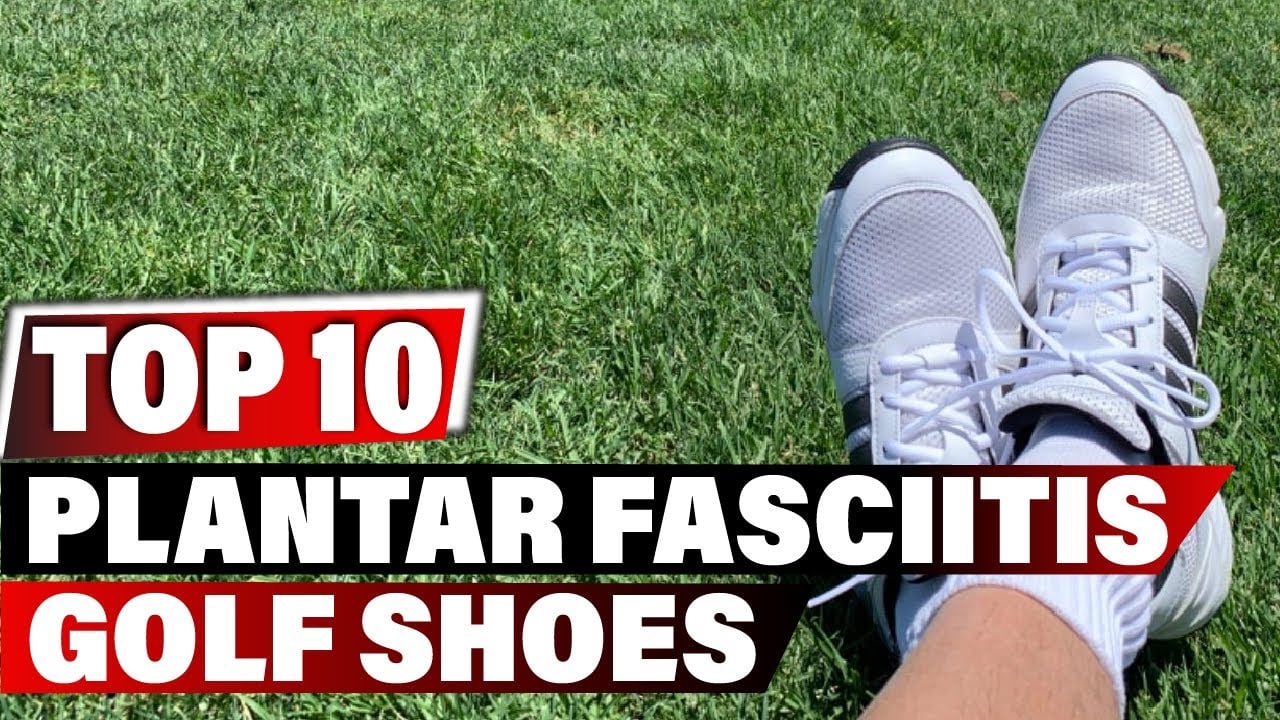



![Unleash Your Potential: In-Depth Analysis of the Callaway Golf Rogue ST Max OS Lite Iron Set Review [2023]](https://www.fairwayfindings.com/wp-content/uploads/2023/07/Callaway-Golf-Rogue-ST-Max-OS-Lite-Iron-Set-Review-768x569.jpg)
